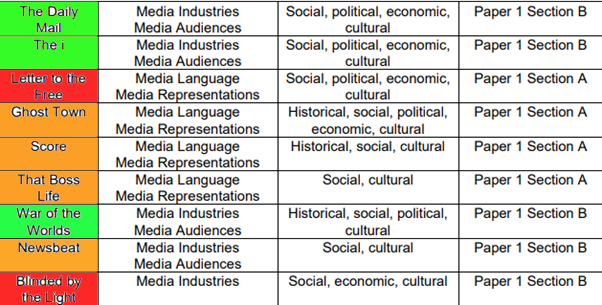- Sentient: The ability to feel and perceive things
- AI (Artificial Intelligence): The development of computerised systems which are able to perform activities and tasks which a regular human can do as well as performing like a human being.
- the transformation of social interaction (audiences);
- the transformation of individual identity (audiences and representation);
- the transformation of institutional structures (industry); and the changes in textual content and structure (language).
- The transformation of audience consumption
The way media has changed across the decades:
- Speed
- Access
- Storage
Alex Krotoski
- The idea of how our minds process information is interesting, with the suggestion that we do not think in a linear or sequential way, but associatively and sensorily, so that information is linked to patterns, consequences, almost like nodes of hyperlinked information.
| TOPIC | NOTES |
| The Printing Press (Gutenburg) in the Medieval period mid 1400’s | |
| Impact of new technology in South Korea as a result of promoting greater digital interaction (speed, connectivity, spread etc) | |
| On-line / digital connection stats | – Average amount spent on social media in 2022: two hours and 27 minutes, a day in 2022 – Facebook leads the world in monthly active users, with all four of the top four apps, followed by TikTok, Amazon, Twitter, and others in 2022. 2.93 billion active users. – Average of 8.39 hours of 13 to 18 use social media. – In 2021, over 4.26 billion people were using social media worldwide, a number projected to increase to almost six billion in 2027 – China, with 1,021 million users, is the country with the most social media users as of 2023. India ranks second with 755 million, and the United States makes it to the third spot with 302 million users. |
| Theodore Vail | – The Network effect |
| Norbert Weiner Loop Theory | |
| Robin Dunbar – The Dunbar Number | – The Dunbar number suggests that connectivity for individuals, communities or groups is typically 5 o 6, with an upper limit of 150. – So who benefits from greater connectivity? Companies, organisations, institutions – ‘small elites dominate’ (Andrew Kean) |
| Clay Shirky | – An American writer, consultant and teacher on the social and economic effects of Internet technologies and journalism. |
| B.F Skinner | – Skinner believed that free will was a illusion and that actions of humans were dependent on consequences of previous. This is the theory of reinforcement. |
| Vannavar Bush | |
| Tim Berners–Lee | |
| Conclusions, suggestions, reflections and predictions | |
| Marshall McLuhan | – The Global Village – ‘a sophisticated interactive culture’ |
The Exchange of Data (The Great Hack:)
Search for Truth
- “Nothing is what it seems” – Carolyn – The Great Hack (Postmodernism)
Behaviour Management
Propaganda / Persuasion
- Use of social media to persuade peoples opinions on political matters.
Regulation
Jaron Lanier
- Produced 4 books: – One-Half of a Manifesto (2000) / Post-symbolic communications (2006)








